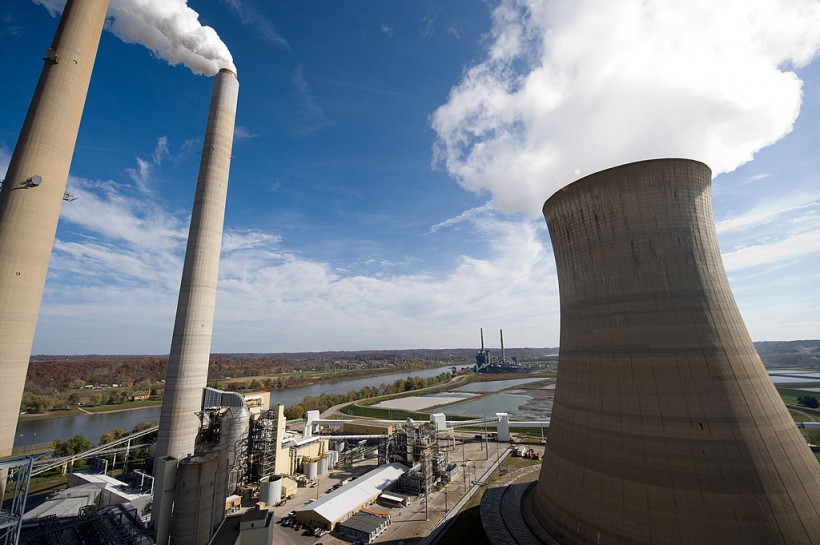Carbon capture development advances once again as a new study presents a unique approach to capturing carbon dioxide straight from the air. According to the new paper, the novel technology is powered by hydrogen and can extract 99 percent of the CO2 from the natural air.
Carbon Capture and Storage Inspired by Fuel Cells

American Electric Power's (AEP) Mountaineer coal power plant, including cooling tower and stacks in New Haven, West Virginia, October 30, 2009. In cooperation with AEP, the French company Alstom unveiled the world's largest carbon capture facility at a coal plant, so called "clean coal," which will store around 100,000 metric tonnes of carbon dioxide a year 2.1 kilometers (7,200 feet) underground.
The new carbon capture method was developed by experts from the University of Delaware. The device in which the system is intact comes in a small size. The authors of the study consider the concept a potential advancement in the future of carbon capture.
The CO2 capture device, according to the experts, could lead to a better efficiency impact in terms of fuel cells in cars.
Carbon capture and storage (CSS) is one of the newest sets of technologies that could preserve the current energy source of today and run other devices through reusable energy. Scientists believe that concepts like carbon capture and storage could be part of the collective answer against the risk of climate change.
Carbon capture system involves the collection of carbon dioxide produced by burning fossil fuels. Most levels of these chemicals are gathered directly from power generation emissions. After capturing a certain amount of the CO2, the chemical is then stored on a specialized vessel kept underground.
The study was led by the University of Delaware's Center for Catalytic Science and Technology expert Yushan Yan, along with their colleagues.
Fuel cells can provide energy by converting fuel chemical technology into electricity. Fuel cells are fit for technology equipped in hybrid or zero-emission vehicles.
Lead author Yan is known for his works on efficient fuel cells alongside the University of Delaware's chemical and biomolecular engineering chair Henry Belin du Pont. Throughout their studies, the experts found improvements on a system comprised of hydroxide exchange membrane (HEM) fuel cells, which is considered both environmentally friendly and economical.
ALSO READ: Useless Plant Part Found as Effective Biomass Source for Creating Sustainable Materials
Captures 99 Percent of CO2 Straight from Natural Air
HEM fuel cells could be an alternative to the traditional fuel cells with acid-based construction. They are commonly used today. However, all types of fuel cells are vulnerable to the carbon dioxide contents found in the natural air. This sensitivity makes it hard for HEM fuel cells to "breathe."
The disadvantage discovered throughout the 15 years of research by Yan's team might have been the solution they are waiting for in terms of carbon dioxide removal. Brian Setzler, University of Delaware's Department of Chemical and Biomolecular Engineering expert and co-author of the study, said in a Yahoo News report that once their team analyzed the system, they found that fuel cells captured each of the carbon dioxide contents that come near them. Moreover, the system performed well in separating the CO2 on the other side.
By transferring the fuel cell's "self-purging" concept into a separate device, the team was able to form a CO2 separator. Yan explained that their study found an approach with substantial effectiveness. An electrochemical cell measuring two inches by two inches captures 99 percent of carbon dioxide from the natural air at a rate of approximately two liters per minute.
Co-author Lin Shi added that their approach was risky but was improved through modifying the circuit of the fuel cells through hydrogen. With the electrically shorted membrane, the fuel cells could manage bulky components.
An early prototype of the system can filter 10 liters of air per minute, eliminating 98 percent of carbon dioxide quickly during the tests. The system was encapsulated on a canister similar to the size of a 4.5-liter milk bottle and is portable for use in other places.
The study titled "A shorted membrane electrochemical cell powered by hydrogen to remove CO2 from the air feed of hydroxide exchange membrane fuel cells" was published in Nature Energy.
RELATED ARTICLE: World's Lightest Magnesium Form Developed: Scientists Introduce in New Experiments, Rare, Short-lived Isotope
Check out more news and information on Chemistry in Science Times.














